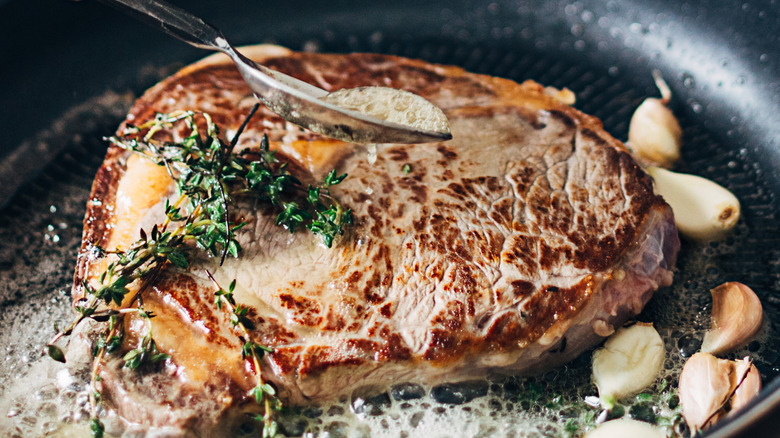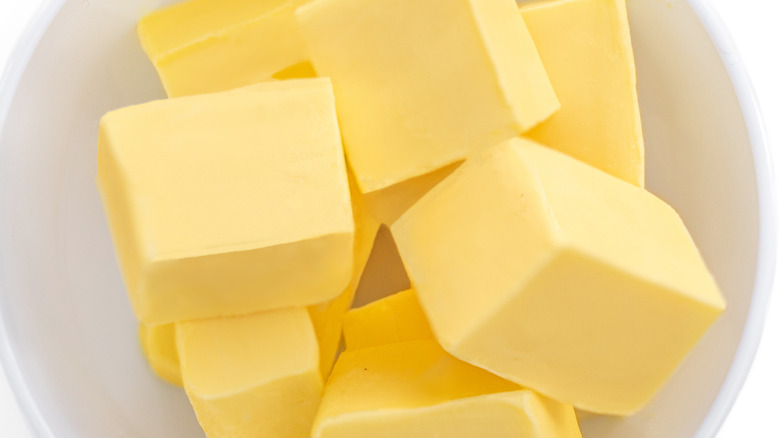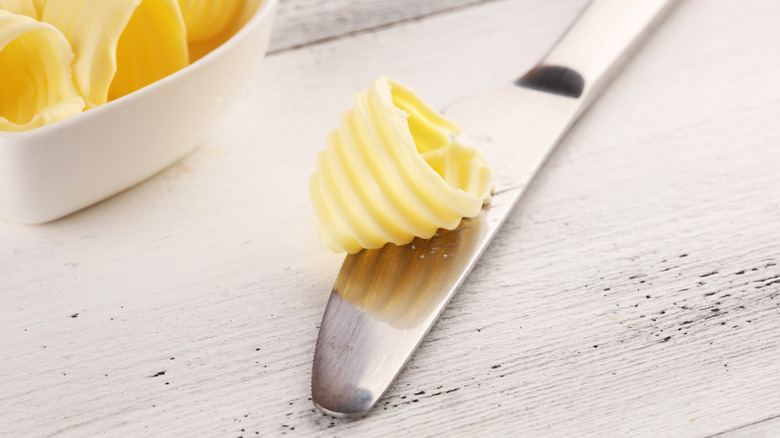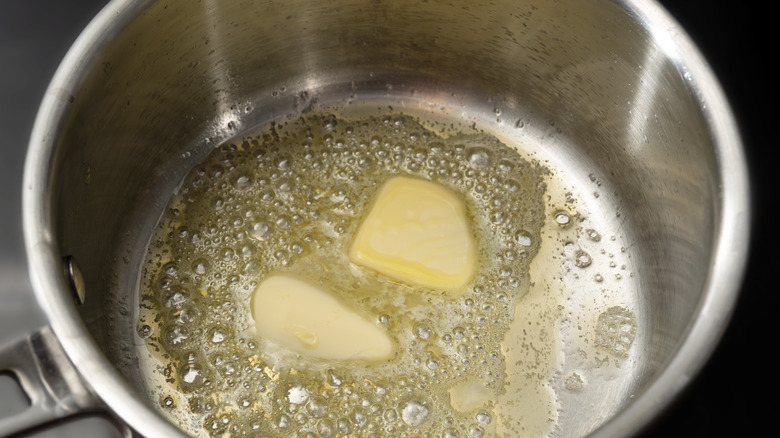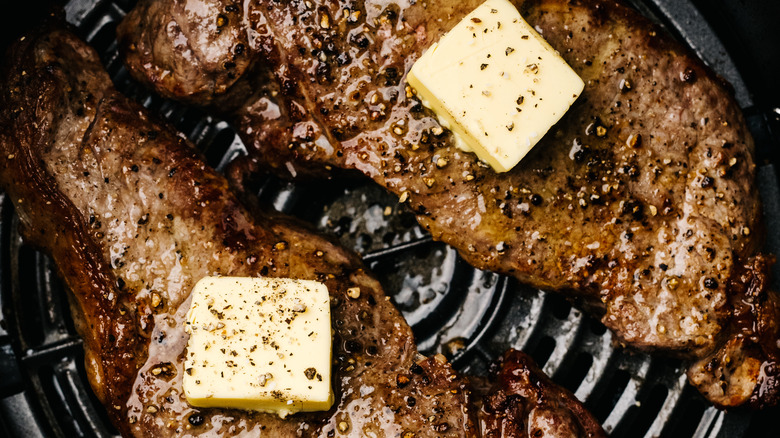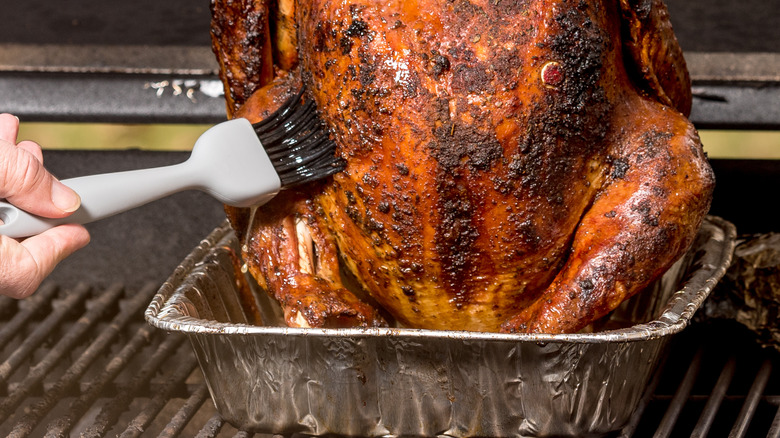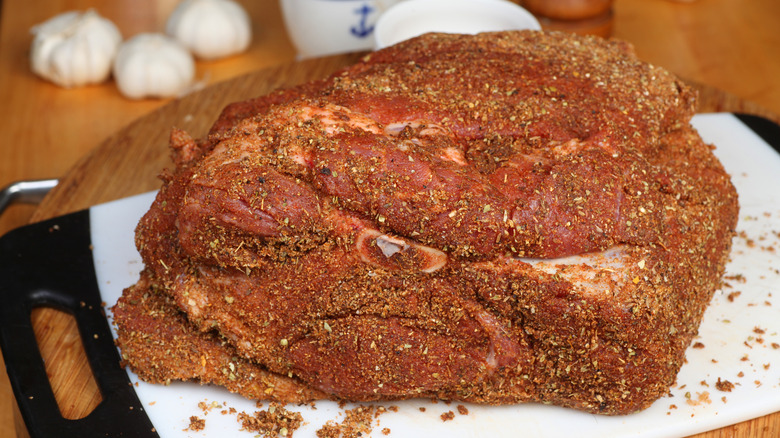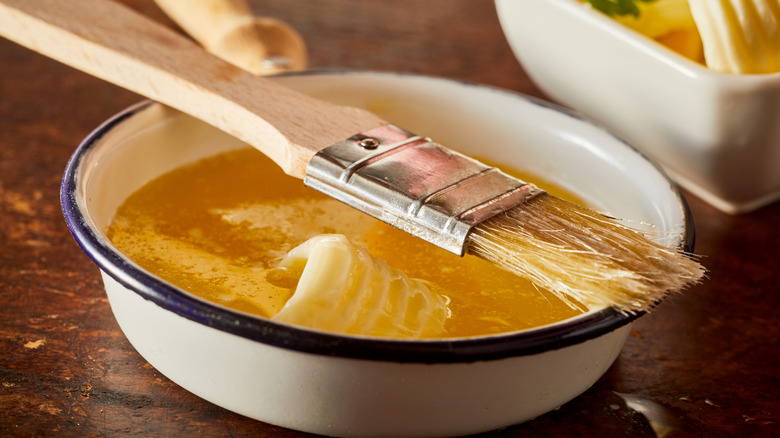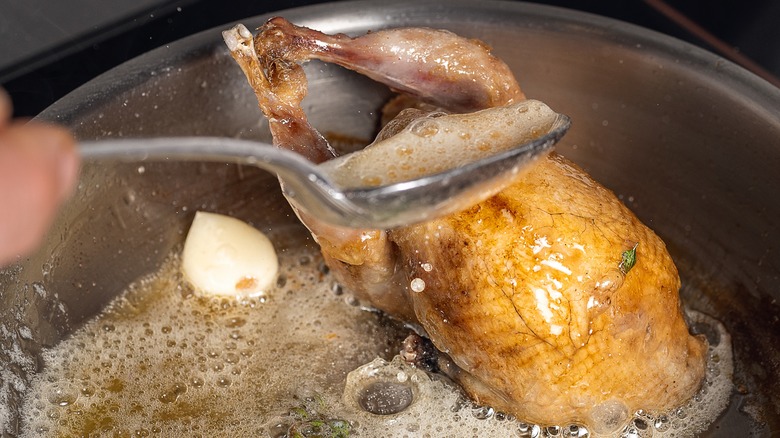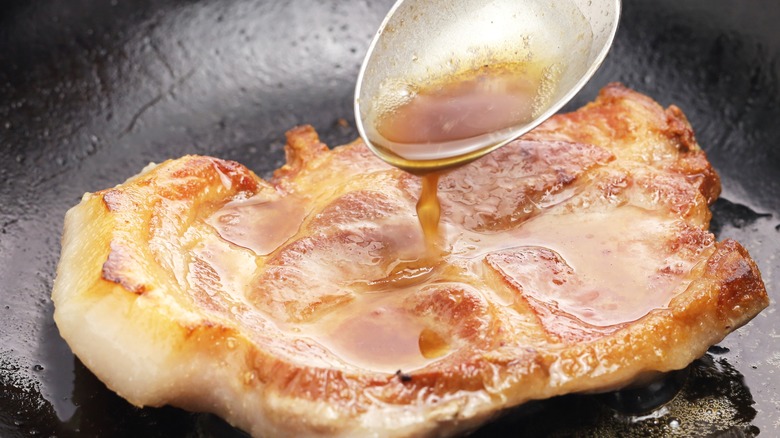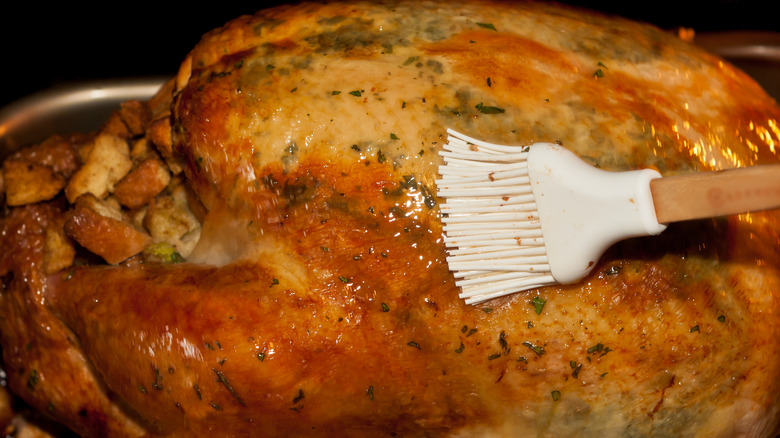Mistakes Everyone Makes When Butter Basting
Whether you're cooking up hearty cuts of beef like ribeye, sirloin, or filet mignon, or you're anxious to chow down on some delectable pork chops or pork tenderloin, or you're just looking for some moist and incredible chicken or turkey, few cooking techniques provide better-tasting meat than butter basting!
Adored by high-end chefs and home cooks alike, butter basting is the process of spreading melted butter over meat as it cooks. And as far as cooking techniques go, the payoff from this one is incredible! Meat that has been butter-basted during preparation is incredibly moist—the butter seeps into the meat and keeps it from drying out. It's also amazingly flavorful, since the butter mixes with the juices from the meat as it melts, creating even richer, more savory meat.
If that weren't enough of a reason to make you a convert, butter basting also helps to create beautiful crusts on meat. As the butter sizzles in the pan, it creates a flaky, golden brown caramelized layer on the outside of the meat that is delicious on its own, and also helps to seal in the juices and keep the meat moist.
But while the butter basting process is simple—and yields incredible results—it is possible to mess it up. Common mistakes in butter temperature and basting technique can doom cooks of any experience level. Here's a look at some of those most common basting errors, plus some tips and tricks to help you to avoid them!
Using too much butter
While butter basting meat has an incredible payoff, it's important not to drown your meat with butter either. This is definitely a case where more isn't better.
Although the amount of butter you should use when butter basting meat will vary depending on the size and type of the meat you are cooking, most experts recommend a simple formula of about two to four tablespoons of butter per pound of meat.
Even if you exceed this amount a little, it's important not to go too heavy on the butter—and not just because of those extra calories.
When you use too much butter, the excess can easily burn during the cooking process. This is especially true if you're cooking at high temperatures. And as delicious as butter is—burnt butter is not. It's acrid and bitter.
Using too much butter can also leave your meat tasting greasy and heavy, which is also a definite no-no.
In general, when butter basting, start the process by heating a skillet over medium-high heat. Then add your recommended tablespoons of butter. Let the butter melt and begin to foam, then add your meat to the skillet.
Using a basting brush, working at regular intervals, baste the dish with the melted butter and spread it over the meat as it cooks. If you notice your butter beginning to smoke or starting to turn brown, you're either cooking over too high a temperature or you're likely using too much butter.
Not using enough butter!
In some ways, butter basting is a lot like the story of "Goldilocks and the Three Bears." You don't want to use too much butter, but you also don't want to use too little! The goal is to stick in the middle and keep your level of butter just right.
While using too much butter when butter basting can leave your meat greasy, or increase the chances of your meal tasting burnt, using too little creates its own sets of problems. For starters, using too little butter can lead to dry and tough meat. When butter basting, you want to add moisture and flavor. So if you skimp on the butter, your meat may not gain any additional moisture. This can leave it dry and tough—sort of like a charred hockey puck.
Utilizing too little butter also means that you aren't adding that desired rich and sumptuous flavor to your dish. It will end up bland and plain, almost as if you hadn't bothered basting it at all.
Perhaps worst of all, using too little butter during the basting process can also cause your meat to cook unevenly. When basting, butter helps pork, chicken, and beef to cook evenly by distributing heat more effectively. When you limit the amount of butter you baste with, you are much more likely to end up with meat that's raw in some areas and overcooked in others—and nobody wants that!
Using the wrong temperature butter
Just as the amount of butter you use when boasting has to be "just right," so too does the temperature of the butter you are basting with. When butter isn't hot enough, it won't properly coat and flavor your meat. Butter that's too cold can solidify and not properly coat your food, or can lead to uneven browning.
To make sure butter is the ideal basting temperature, start with soft, room temperature butter. Then, when you add your butter to your skillet or pan, let it melt over low heat—you don't want it burning or turning brown.
Look for bubbles. As butter melts and heats up, it will start to bubble. Once the bubbles begin to dissipate, your butter is at the right temperature for basting. (This is generally around 250-275 degrees Fahrenheit—you can use a thermometer to check if needed.)
Should you try cooking meat with butter that is too cold and below this temperature range, you will find that your meat won't sear properly and won't have that crispy crust you're looking for. It can also take longer to melt and coat the meat, which can lead to uneven cooking.
On the flip side, if the butter you use for basting is over the recommended temp, you'll likely struggle to keep it from burning and can expect to end up with greasy, bitter-tasting meat—which is not what anybody is looking for dinner!
Basting with the wrong type of butter
When it comes to butter basting meats, not all butters are created equally. While salted butter may taste better spread on a piece of toast, unsalted butter is the definite winner. Salted butter may pack that sublime, subtle salty taste, but it also has a lower smoke point than unsalted butter—meaning it burns at a lower temperature. As we've already discussed, burnt butter is one of the major challenges of butter basting, so anything that lessens the chances of your butter burning is a definite advantage. Salted butter may also leave meat tasting ... well, salty. Unsalted butter has a more neutral flavor, which allows the natural flavors of the meat you are cooking to shine through.
If you want to step up your butter game a notch, consider using an organic unsalted butter, which can bring in some of the natural grass-like flavors of the milk from those organically-raised cows. European-style unsalted butter is another great basting option. This butter is churned for a longer period of time than regular butter so it has a richer, creamier flavor. It's higher fat content also gives it a higher smoke point, which again reduces chances of burning while you cook.
Plant-based butters like avocado oil butter can also be good butter basting options—but steer clear of basting with margarine. It lacks the richness of butter and is also packed with fats, additives, and preservatives that are less healthy for the body.
Cooking meat you want to butter baste in the wrong pan
Picking the right pan or skillet is another essential part of the butter basting process. And it's one decision that can greatly impact the overall success (or failure) of your dish.
When selecting the pan you plan on basting meat in, always ask yourself the following questions:
- Are the sides high enough?
- Is it big enough?
- How thick is the bottom?
In general, if you pick a pan with sides that are too low, you're going to end up with a mess. The butter and meat will splatter uncontrollably and you won't be able to easily correct the problem without interrupting the cooking process.
Similarly, selecting a pan that's large enough for whatever you are cooking is key. If the pan is too small, it can cause overcrowding and your meat may end up undercooked or too brown. You want a pan that's big enough for all of the meat and that you can easily move your hand around in to ensure proper basting. Pans that are too small can also require longer cooking times, increasing your risk for dry or overcooked meat.
Finally, when butter basting, remember that a heavy-bottomed pan such as a cast-iron skillet for steak or a roasting pan for turkey is going to perform better than something with a much thinner bottom. That extra denseness in your pan helps to distribute heat evenly and further prevents your butter from burning.
Not seasoning your food before basting it
If you want the best butter-basted meat possible, you also need to be sure to season it properly before the cooking process ever begins. This crucial step is true no matter what you might be preparing, from thick and juicy steaks to crispy pork chops to tender chicken thighs.
There are several different easy options for adding some spice and flavor to meat before you add it to your basting pan. For starters, consider a dry rub. This mixture of spices and herbs can be rubbed directly onto the meat before cooking. Buy a mix that sounds appealing, or experiment and make your own by combining a few different spice favorites, such as salt, black pepper, paprika, garlic powder, cumin, and chili powder.
Marinades are another great option to add depth and complexity to any meat you are butter basting. Consider a quick blend of soy sauce, brown sugar, garlic, and ginger or maybe a citric blend of lemon juice, olive oil, garlic, and rosemary as two simple homemade marinade options. Fruit juice, wine, and vinegar on their own are also good instant marinade options!
Finally, for extra flavor you can also add spices and aromatics directly into the butter you use for basting. Consider stirring minced garlic, sliced shallots, or diced onions into butter before you baste with it, or add fresh herbs, such as thyme, rosemary, or sage to your butter as it is melting.
Trying to baste food that is too wet
This one comes down to simple logic: if you try to baste a piece of meat that is too wet, your butter may not properly adhere to it.
Whether you're cooking up a platter of steak, chicken, pork, or turkey, it is essential to make sure that each cut of meat has been properly patted dry before basting.
In addition to allowing your basting butter to simply roll off your meat, excess moisture also impacts the cooking process in other ways. Water or other liquids on the surface of a piece of meat can create steam that softens the surface of the meat and prevents it from browning and forming that crispy crust we all love so much.
Too much moisture on the meat you are basting can also cause your butter to splatter when you add it to the pan, increasing risk for painful burns and creating a giant mess in your kitchen. (If you don't have one, invest a few bucks in a splatter screen to protect the safety of your hands and also make post-basting oven clean-up a breeze!)
Meat that is exceedingly moist will also tend to cook more slowly, increasing the chances you end up with a plate of food that's dry or chewy. Or, that excess moisture can blend with your basting butter, creating an oily sauce-like mixture that can coat your meat. Either way, your meal is surely spoiled.
Basting at the wrong times
Okay—you've got the right butter at the right temperature, plus the right pan to cook your meat. Your meat is seasoned and you're ready to start cooking. The last thing you need to consider when preparing amazing butter-basted meats is making sure you are basting at the right times in the cooking process.
So when is the right time to baste? In general, aim to wait until the meat has formed a crust before you start basting. The amount of time you need to wait for a crust to form on any meat you are cooking will vary but typically you'll want to allow 2 to 3 minutes per side when cooking a steak, and about 5 to 10 minutes for when cooking poultry.
If you baste before your meat has had time to form that crust, your basting butter may inhibit the proper formation of a crust on your meat. Instead of forming that crispy delicious outer later, the water in the butter will create steam that can soften the surface of the meat, preventing it from browning and crusting properly.
Similarly, basting too late is not ideal either. In this case, the meat can start to dry out as it cooks, making the surface less receptive to the butter. In other words, when you wait too long to baste, your butter can simply sit on top of the meat, rather than soaking into it and adding flavor and moisture. Blech!
Basting too frequently
Just as you don't want to start the basting process too early or wait too long to get it going, you also don't want to baste too often either.
Basting meat too frequently can cause your meal to steam instead of properly browning. Over-basting can also leave food tasting greasy and can mask both the flavor of your meat plus all those spices and other aromatics you've added to your pan.
To know when you need to add butter, focus on your senses. Start by watching the color of your meat as it cooks. Once the meat has developed that golden-brown crust and you flip it over, is it starting to look dry? If so, it may need some extra butter. Sniff the scent of the butter as your meat cooks. You should smell a pleasant nutty aroma as the meat is browning. If you start to smell anything that seems burned, lower your temp a bit and add more butter.
Also, carefully press the meat with your fingertips. If it feels firm, it's likely cooked medium-rare or medium. If the meat is still soft and spongy, it's likely not cooked through and you can add more basting butter.
If at any point you're unsure about the doneness of your meat, stop basting! It's best to err on the side of caution and stop basting a little early than to let your meat cook too long and end up dry or greasy.
And the biggest mistake you can make when butter basting? Not using a basting brush!
Basting brushes may seem like pointless gadgets that just fill up your kitchen drawer, but when it comes to butter basting, no tool is more useful or effective.
Sure, you can go old school when basting meat and use a spoon—but unless you're a pro, it's very hard to distribute that butter evenly over the meat you're cooking. A basting brush allows for precise application of your basting liquid, ensuring that each part of the meat is evenly coated.
Brushes also provide better control over the amount of butter you're using as well as the amount of force you use when basting delicate foods like fish filets—important so they don't break apart while cooking.
And as for those funny-looking butter basters we all make jokes about once a year when preparing the holiday turkey? You don't need them! Even with large pieces of meat like a roast chicken or turkey, basting brushes are better. They're easier to keep clean, reducing your risk of food-borne illness or contamination. They're also less messy, and less likely to drip butter all over the place as you cook.
Finally, and perhaps most importantly, basting brushes are more versatile in the kitchen. Once you've invested in a good, high quality silicone or heat-resistant nylon basting brush, you can also use it for other common cooking tasks, such as brushing barbecue sauce onto ribs or glazing a ham.
